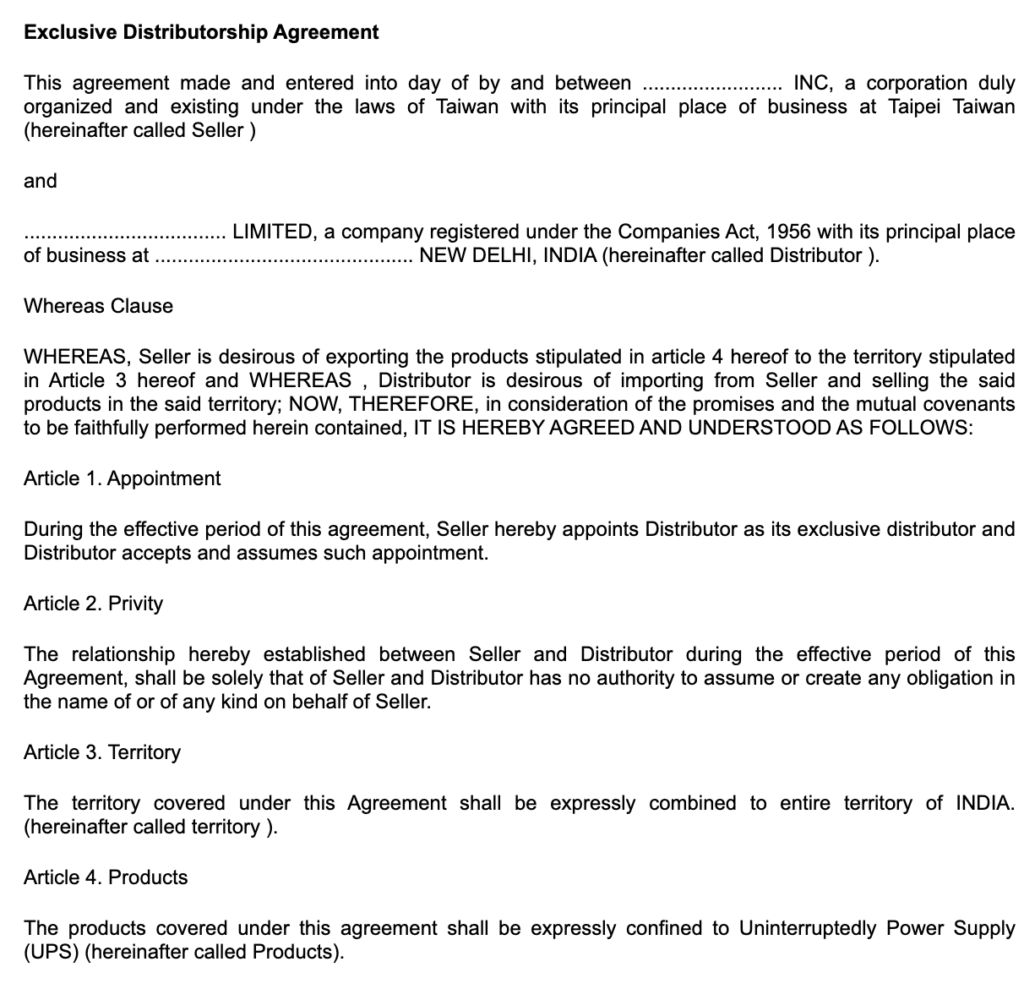There are currently over 3,800 Indian franchisors offering a wide variety of franchise opportunities in the country. Businesses in the food and beverage, academic, retail, health and wellness, and consumer service sectors, among others, often turn to franchising as a means of expansion. One of the largest sectors of the franchise industry is the food service industry and obviously, the search for the perfect restaurant franchise agreement in India sample PDF draft is very high.
Nevertheless, F&B is the largest and fastest growing in the market. Let us understand Restaurant Franchising in India, how you can draft the perfect Restaurant Franchise Agreement for your business, and all the legalities involved, and create the best food franchise agreement in India for your brand from the best food franchise consultants in India.
Restaurant Franchise Agreement Sample in India

Why do you need a Restaurant Franchise Agreement in India?
In exchange for financial investment, a restaurant might provide another business with the right to utilize its brand, including its name, recipes, design, trademarks, and logo.
Moreover, the agreement specifies the terms and conditions for the franchisee to follow, including those pertaining to the menu, the style and layout, the service, the employees, etc.
Popular Indian brand owners with a sizable client base are pursuing the franchising model, just like their counterparts in the worldwide food industry.
Some of the most well-known Indian franchises are Barbeque Nation, Moti Mahal, Haldiram, Sagar Ratna, and Swagath. These restaurant franchises have established themselves as leaders in India’s food and beverage sector.

Essential Elements of Restaurant Franchising in India
The specifics of franchise agreements vary depending on the company. Nevertheless, these contracts should include the following standard provisions:
1. Scope of the business
The franchise agreement should detail the business, its extent (geographic, temporal, etc.), and the length of the franchise.
Franchise agreements should specify if the business is a fine dining establishment, a cafe chain, a takeaway or fast food restaurant, a pizza shop, a mobile food vendor or a kiosk.
As the agreement’s prologue, this provision is essential since it will be used to determine the parties’ actual intentions.
2. Location
Provision of the franchise location is assigned by the franchisor, using the franchise agreement. The two types of territories are exclusive and non-exclusive.
In an exclusive territory, the franchise cannot sell the products beyond the boundaries specified. Non-exclusive territory means the franchise can add multiple units within the same territory.
3. Contract Term & Contract Renewal Clause
The duration of a franchise agreement, both during its first term and any subsequent renewal terms, is specified here. A franchisee is granted permission to run the franchised unit during the specified term of the agreement.
The franchisee may, according to the terms and circumstances set forth in the agreement, renew the franchise under its terms and conditions.
4. IPR, Licensing and Confidentiality
The restaurant that is offering the franchise should lay forth the parameters, guidelines, and conditions for the use of IPR. The franchise agreement contains safeguards designed to prevent the franchisee from undermining the brand’s reputation and market value through improper exploitation of the franchisor’s intellectual property.
5. Franchising Fees & Royalty Fees
The franchisee’s initial and ongoing non-refundable franchise fees, as well as any other one-time fees, must be specified. Payment terms, including frequency and method, must also be specified.
It is also important to include royalty clauses that specify the amount (typically expressed as a percentage) of the franchisee’s payment to the franchisor that is non-refundable.
6. Termination Clause
Default and termination provisions for the franchise agreement should also be included in this clause. Defaults such as a major breach of the agreement, a party’s legal inability to implement the agreement, a party’s bankruptcy or insolvency, or a change in the legal or regulatory environment in the country may be grounds for termination.
7. Dispute Resolutions
In the event of a dispute between the franchisor and the franchisee, the parties agree to submit their differences to the court with jurisdiction over their location. In the event of a dispute, the parties should include an arbitration clause outlining the location of the arbitration, the institution that will hear the case, and the procedures to be followed.
Legal Provision to be Included in Restaurant Franchise Agreement in India
There is no overarching law in India that regulates franchising generally. But there are provisions in several Indian companies and industry-specific legislation that can help you out with different parts of running a franchise.
A general principle of good faith and fair dealing is adhered to in place of the absence of any specific requirements for any pre-contract disclosure and any legislative responsibility to offer any information to the potential franchisee under Indian law.
Below are some of the basic cafe franchise agreements and food franchise agreements in India terms and conditions that need to be included.
1. Franchise Agreement Validity and Enforceability
In legal terms, a franchise is a contract between two parties. Therefore, the Indian Contract Act, of 1872 (the “Contract Act”) may apply to franchise agreements depending on the specifics of the deal. The following are some of the requirements for a contract to be valid under the Contract Act:
- Proposal
- Offer Acceptance
- Explicitly permitted by applicable law
- lawful intent and use;
- Agreement based on mutual consent;
- How legally competent the parties are to enter into the agreement;
- Legality.
For a Franchise Agreement to be enforceable in court, it must comply with the requirements set forth in Section 10 of the Contract Act.
Although the Contract Act does not require a contract to be in writing, it is nonetheless best practice to have a written franchise agreement that specifies the rights and obligations of each party.
2. Protection of IP rights
In most cases, the rights to use a trademark, logo, service mark, or trade dress belong to the franchisor (think McDonald’s or Barista Coffee), and this means that the parties to a franchising agreement must consent to the transfer of these items.
Given the centrality of the intellectual property license to a franchise, intellectual property licensing rules should be carefully considered when drafting a franchise agreement for a food service establishment.
Several laws, including the Trademarks Act of 1999, the Patent Act of 1970, the Design Act of 2000, and the Copyright Act of 1957 address this issue. The franchise agreement’s trademark, patent, design, copyright, etc. are all subject to these laws.
Registration under the Trademark Act safeguards the distinctive symbol used to identify a product or service.
3. Rivalry and unfair business tactics
Production, supply, distribution, storage, acquisition, or control practices that may have considerable adverse effects on competition within India are illegal under the Competition Act, of 2002.
The agreement should be checked for any antitrust or restrictive trade practices that could limit competition in the market and lead to the establishment of a monopoly.
Agreements involving restrictive trade practices in the provision of services or in the production, storage, supply, distribution, or control of commodities are required to be registered with the Director-General under the Monopolies and Restrictive Trade Practices (MRTP) Act, 1969.
The franchise agreement mandates that neither party engage in monopolistic or restrictive behaviour.
4. Responsibility under the Tort Law
Any party to a franchising arrangement (franchisor or franchisee) may be held liable for the other’s (or a third party’s) losses or damages if they breach a duty owed to the franchisee or to the franchisee’s customers.
5. Corporate and tax liabilities
If the franchisor and franchisee are both registered in India as corporations, they must follow all laws and regulations pertaining to corporations in that country, including the Companies Act, 2013. The company’s directors may be held accountable for their decisions.
6. Consumer Protect Act 2019
The Consumer Protection Act of 2019 provides various protections for consumers against deceptive business practices. Customers have recourse both against the franchisee and the franchisor in the event of a product or service failure.
7. Labour & Property
Real estate and leasehold law play a significant role in the franchising industry. Different labour laws would apply depending on the terms and conditions of the legal connection between franchisor and franchisee regarding franchise business activities.
The franchisees in restaurant franchises are considered independent contractors since they make all the important decisions including who to hire and how much to invest in the business.
8. Arbitration and Conciliation Act, 1996
Any time a disagreement needs to be resolved, the Arbitration and Conciliation Act of 1996 comes into play. If a dispute arises between the Franchisee and the Franchisor, arbitration is an option for resolving the problem.
Also Read: How Sparkleminds can help in solving disputes through Mediation and Arbitration
Types of Restaurant franchise agreements in India
These include:
- Master Franchise Agreement
- Single Unit Franchise Agreement
- Multi-Unit Franchise Agreement
- Company-Owned Franchise Agreement
Each of these franchise agreements has a different purpose but will have some common terms applicable to the other party.
Conclusion,
Even without corresponding legislative or regulatory reforms, the restaurant franchising industry has grown rapidly over the past three decades. Despite the restaurant franchise industry’s meteoric rise and bright future in India, we lack sector-specific legislation and regulation.
There are no rules governing the establishment and operation of franchise restaurants, so the agreement between the parties must be comprehensive, including provisions from all applicable laws.
The costs and delays associated with protracted litigations can be avoided with the help of a thorough agreement that includes all the relevant clauses in the event of a conflict of interest.
Get in touch with our experts at Sparkleminds to know how to draft a franchise agreement for a restaurant in India.
![]()










